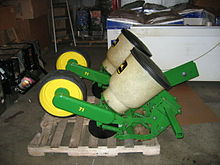


A planter is a farm implement, usually towed behind a tractor, that sows (plants) seeds in rows throughout a field.[1][2] It is connected to the tractor with a drawbar or a three-point hitch. Planters lay the seeds down in precise manner along rows. Planters vary greatly in size, from 1 row to 54, with the biggest in the world being the 48-row John Deere DB120. Such larger and newer planters comprise multiple modules called row units.[1] The row units are spaced evenly along the planter[1] at intervals that vary widely by crop and locale. The most common row spacing in the United States today is 30 inches.[1]
- ^ a b c d "planter technology - John Deere planters - corn planters". farmindustrynews.com. Archived from the original on 2004-09-27.
- ^ "Kimberley says keeping the planter's row units in excellent condition can cut yield losses by 5-30 bu./acre". cornandsoybeandigest.com. Archived from the original on 2008-04-11.